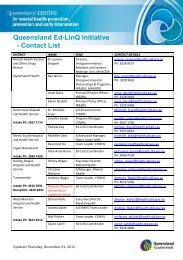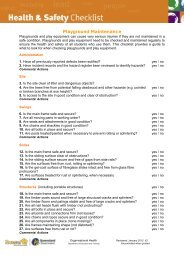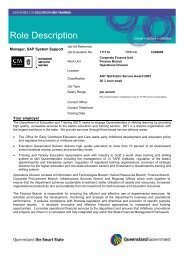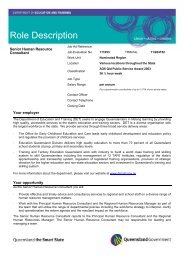1. What must be done to ensure electrical safety in schools? 2 ...
1. What must be done to ensure electrical safety in schools? 2 ...
1. What must be done to ensure electrical safety in schools? 2 ...
You also want an ePaper? Increase the reach of your titles
YUMPU automatically turns print PDFs into web optimized ePapers that Google loves.
2. General procedures for all <strong>electrical</strong> equipment<br />
Legislation requires that the <strong>safety</strong> of all <strong>electrical</strong> items <strong>must</strong> <strong>be</strong> <strong>ensure</strong>d. The follow<strong>in</strong>g general<br />
procedures should <strong>be</strong> followed for the use of all <strong>electrical</strong> equipment:<br />
<strong>1.</strong> Ensur<strong>in</strong>g ‘<strong>in</strong>-built’ <strong>safety</strong> features of <strong>electrical</strong> equipment rema<strong>in</strong> <strong>in</strong>tact:<br />
Appropriately designed and manufactured <strong>electrical</strong> equipment has some ‘<strong>in</strong>-built’ <strong>safety</strong> features<br />
that protect the user from harm related <strong>to</strong> electricity. Importers, designers and manufacturers of<br />
<strong>electrical</strong> equipment have obligations <strong>to</strong> <strong>ensure</strong> equipment is <strong>electrical</strong>ly safe.<br />
To <strong>ensure</strong> these features rema<strong>in</strong> <strong>in</strong>tact and are effective;<br />
Use equipment accord<strong>in</strong>g <strong>to</strong> <strong>in</strong>structions<br />
Use appropriate equipment for the task – e.g. do not use domestic equipment for <strong>in</strong>dustrial<br />
purposes<br />
Do not remove any cas<strong>in</strong>gs or covers that enclose <strong>electrical</strong> parts<br />
Do not <strong>in</strong>sert <strong>in</strong>appropriate items (e.g. metal implements) <strong>in</strong><strong>to</strong> <strong>electrical</strong> equipment<br />
Do not attempt repairs - use a licensed <strong>electrical</strong> contrac<strong>to</strong>r (e.g. an electrician)<br />
2. General care and ma<strong>in</strong>tenance<br />
Protect leads and equipment from damage e.g. position leads and equipment where they are<br />
not likely <strong>to</strong> <strong>be</strong> damaged<br />
Remove faulty <strong>electrical</strong> items from use immediately <strong>to</strong> <strong>ensure</strong> the item is not used<br />
<strong>in</strong>advertently by someone else; clearly la<strong>be</strong>l them as ‘faulty’ or ‘out of service’<br />
Discard faulty <strong>electrical</strong> equipment or have it repaired by an electrician. Sometimes it is more<br />
economical <strong>to</strong> replace the item<br />
Use power boards <strong>in</strong>stead of double adap<strong>to</strong>rs; however, do not overload power boards<br />
3. Mak<strong>in</strong>g regular visual <strong>in</strong>spections<br />
More than 90% of defects are detectable by visual <strong>in</strong>spection. It only takes a few seconds <strong>to</strong> check<br />
the item <strong>be</strong>fore you use it.<br />
Check the lead, plug, socket and item for:<br />
cuts or other damage that exposes the <strong>in</strong>sulation of the <strong>in</strong>ner cores or conduc<strong>to</strong>rs<br />
melted or burnt areas<br />
damage <strong>to</strong> covers, guards and controls (e.g. switches)<br />
cracks and holes that may expose live parts<br />
obstructed ventilation <strong>in</strong>lets and exhausts<br />
deformed leads e.g. permanently twisted<br />
4. Electrical items that are not specified <strong>electrical</strong> equipment<br />
For <strong>electrical</strong> equipment that is not specified <strong>electrical</strong> equipment (e.g. fridges, computers) the<br />
Regulation does not prescri<strong>be</strong> the way <strong>to</strong> <strong>ensure</strong> <strong>electrical</strong> <strong>safety</strong>. This is <strong>be</strong>cause the risks are<br />
seen <strong>to</strong> <strong>be</strong> much lower for these types of equipment. For example, the risks (e.g. of electric shock)<br />
associated with us<strong>in</strong>g a refrigera<strong>to</strong>r <strong>in</strong> a staff room are much lower than the risks associated with<br />
students operat<strong>in</strong>g a power drill dur<strong>in</strong>g <strong>in</strong>dustrial technology.<br />
There is still the general obligation <strong>to</strong> <strong>ensure</strong> <strong>electrical</strong> <strong>safety</strong> for these items so, your school may<br />
choose <strong>to</strong> take extra precautions <strong>in</strong> addition <strong>to</strong> the 3 steps listed above.<br />
For example;<br />
identify if there are any <strong>electrical</strong> items that are exposed <strong>to</strong> damage (see Schedule for examples)<br />
implement a test & tag regime or <strong>in</strong>stall a <strong>safety</strong> switch <strong>to</strong> <strong>in</strong>crease the level of protection for<br />
users<br />
This approach shows a risk management process has <strong>be</strong>en used and is one method of prov<strong>in</strong>g that a<br />
system is <strong>in</strong> place <strong>to</strong> <strong>ensure</strong> <strong>electrical</strong> <strong>safety</strong> for all <strong>electrical</strong> equipment.<br />
Organisational Health Unit Novem<strong>be</strong>r 2008 8
















